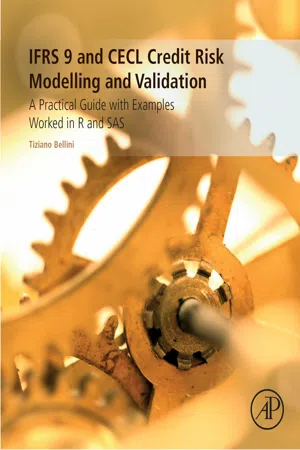
IFRS 9 and CECL Credit Risk Modelling and Validation
A Practical Guide with Examples Worked in R and SAS
- 316 pages
- English
- ePUB (mobile friendly)
- Available on iOS & Android
IFRS 9 and CECL Credit Risk Modelling and Validation
A Practical Guide with Examples Worked in R and SAS
About this book
IFRS 9 and CECL Credit Risk Modelling and Validation covers a hot topic in risk management. Both IFRS 9 and CECL accounting standards require Banks to adopt a new perspective in assessing Expected Credit Losses. The book explores a wide range of models and corresponding validation procedures. The most traditional regression analyses pave the way to more innovative methods like machine learning, survival analysis, and competing risk modelling. Special attention is then devoted to scarce data and low default portfolios. A practical approach inspires the learning journey. In each section the theoretical dissertation is accompanied by Examples and Case Studies worked in R and SAS, the most widely used software packages used by practitioners in Credit Risk Management.- Offers a broad survey that explains which models work best for mortgage, small business, cards, commercial real estate, commercial loans and other credit products- Concentrates on specific aspects of the modelling process by focusing on lifetime estimates- Provides an hands-on approach to enable readers to perform model development, validation and audit of credit risk models
Frequently asked questions
- Essential is ideal for learners and professionals who enjoy exploring a wide range of subjects. Access the Essential Library with 800,000+ trusted titles and best-sellers across business, personal growth, and the humanities. Includes unlimited reading time and Standard Read Aloud voice.
- Complete: Perfect for advanced learners and researchers needing full, unrestricted access. Unlock 1.4M+ books across hundreds of subjects, including academic and specialized titles. The Complete Plan also includes advanced features like Premium Read Aloud and Research Assistant.
Please note we cannot support devices running on iOS 13 and Android 7 or earlier. Learn more about using the app.
Information
Introduction to Expected Credit Loss Modelling and Validation
Abstract
Keywords
Table of contents
- Cover image
- Title page
- Table of Contents
- Copyright
- Dedication
- Tiziano Bellini's Biography
- Preface
- Acknowledgements
- Chapter 1: Introduction to Expected Credit Loss Modelling and Validation
- Chapter 2: One-Year PD
- Chapter 3: Lifetime PD
- Chapter 4: LGD Modelling
- Chapter 5: Prepayments, Competing Risks and EAD Modelling
- Chapter 6: Scenario Analysis and Expected Credit Losses
- Index